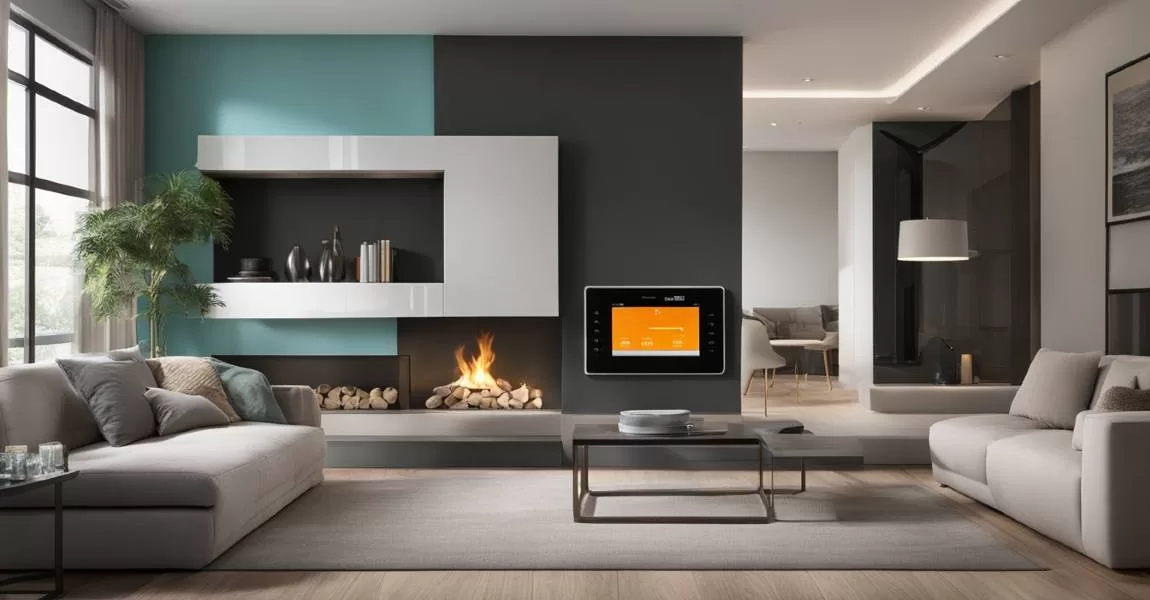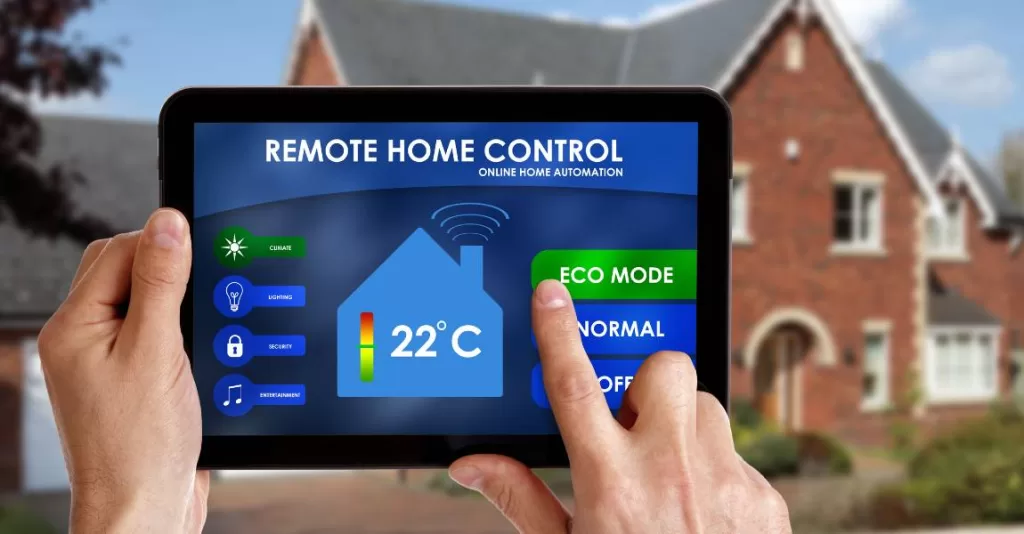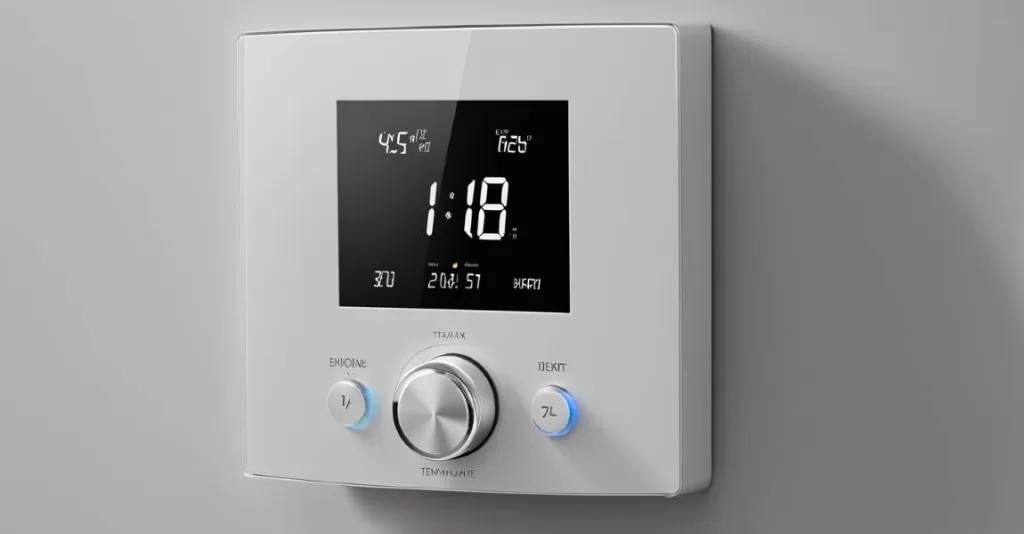With the seemingly endless array of Thermostat Types available today, How to Choose Thermostat that’s an ideal match for your lifestyle can seem daunting. Yet, making this choice is one of the simplest ways to tailor comfort and trim down energy bills in your home. Whether you’re looking to upgrade to a programmable thermostat for up to a 33% reduction in energy costs or seeking straightforward advice on Selecting Thermostat for HVAC compatibility, understanding your options is paramount.
Before you commit to your next thermostat, you must first discern the type of heating and cooling system cradling your domestic haven. This knowledge is the crux of ensuring harmony between your chosen Best Thermostat for HVAC system and the sanctuary you call home. Dive into the diverse landscape of programmable, digital non-programmable, manual, remote, and learning thermostat models to discover which can best streamline your home’s climate control.
Consult this comprehensive guide to maneuver through your HVAC Thermostat Options with the wisdom of a seasoned professional. And if tackling installation seems overwhelming, remember that experts like JD’s Plumbing Heating and Cooling are always ready to help you navigate the process for a perfectly calibrated setup.
Remember, the secret to sustained comfort and efficiency lies in regular upkeep. Periodic attention to your thermostat and your entire HVAC system will bolster its peak performance and keep you snug or cool, no matter the weather outside.

Table of Contents
Key Takeaways
- Understanding the specific needs of your system is critical for thermostat compatibility.
- A diverse range of thermostat options exist, from programmable to learning types, catering to different lifestyles.
- Professional installation is recommended to ensure your thermostat functions efficiently and accurately.
- Regular maintenance of your system, including the thermostat, can significantly improve energy efficiency.
- Programmable thermostats are a cost-effective way to enhance comfort while reducing energy consumption.
- Choosing a thermostat with suitable programming options can optimize your home’s heating and cooling schedules.
- Upgrading to a new thermostat can be a simple step with a notable impact on your home’s energy footprint.
Understanding Your HVAC System Compatibility
When it’s time to upgrade or replace your thermostat, knowing the HVAC System Compatibility is imperative. Your heating and cooling, ventilation, and air conditioning system, requires a Compatible Thermostat for HVAC to operate efficiently and effectively. Whether you have central heating and AC, a heat pump, electric baseboards, or a furnace determines which types of thermostats can be linked with your system. Let’s delve into why this alignment between your thermostat, heating, and cooling system is critical.
Understanding the voltage requirement and system type is essential to choosing a Compatible Thermostat for heating or cooling systems like yours. Some thermostats are exclusively crafted for low-voltage systems, while others are designed for high-voltage or direct-line voltage applications. Pairing the wrong type can lead to system malfunctions or failure.
Familiarizing yourself with your system’s specifics can be as easy as consulting an HVAC professional or checking the system manual. By identifying key features, such as whether your system is single-stage, multi-stage, or has zoning controls, you can prevent the common pitfalls that occur when trying to pair incompatible components.
Remember, an informed choice maximizes home comfort and can optimize energy efficiency, potentially reducing utility expenses. Learn how to Maximize Your Air Conditioning Effectiveness this summer in Denver.
Investing a little time into learning about your HVAC System will pay off in the long run. Ensure that you choose a thermostat that understands and responds to the unique language of your home’s heating and cooling system.
- Central HVAC Systems: Often compatible with a wide range of thermostats, including features like programmable and smart thermostats
- Heat Pump Systems: They may require thermostats that can handle heating and cooling functions and switch between them.
- Electric Baseboard Heaters: Typically require a line-voltage thermostat or one specifically designed for baseboard heating.
- Furnaces: You might need a thermostat compatible with the stage of your heating system, whether it’s single or multi-stage.
Making the right choice is not just about convenience; it’s about creating a harmonious system that works seamlessly to ensure your environment is exactly how you want it. Let’s explore and determine which thermostat will work best for your particular existing HVAC system and how you can guarantee a successful pairing.
Thermostat Types and How to Choose the Right One for Your System
When managing your home’s heating and cooling, selecting the right thermostat for your home could mean a blend of convenience and energy savings. Let’s break down the differences between Programmable Thermostats, Non-Programmable Thermostats, and other variants to help you identify which one aligns with your lifestyle and HVAC needs.
Programmable vs. Non-Programmable Thermostats: Tailoring to Your Schedule
Programmable Thermostats can significantly contribute to your home’s energy efficiency by adjusting to your unique schedule. By setting your temperature preferences for different times of the day or week, you could be cutting down on unnecessary energy use and costs.
On the flip side, Non-Programmable Thermostats provide a constant temperature setting that can be manually changed whenever you wish, offering simplicity for those who are home often and prefer a fixed setting.
Manual Thermostats: Simplicity and Consistency
If digital isn’t your style, Manual Thermostats are as straightforward as it gets. A simple dial or slider makes these easy to operate, requires no programming, and cannot set multiple temperature preferences.

Remote and Wi-Fi Thermostats: Control at Your Fingertips
Then we have Remote Thermostats and Wi-Fi Thermostats for those who love technology and convenience. With these devices, a homeowner can adjust settings and remotely control from virtually anywhere using a smartphone app or tablet, providing ultimate control and the ability to respond to sudden changes in your plans or weather conditions.
Learning Smart Thermostats: Intelligent Heating and Cooling System
Learning Thermostats represent the pinnacle of smart home technology. These devices learn from your behavior to create a schedule that automatically adjusts to temperature preferences, ensuring both comfort and efficiency without you having to lift a finger.
| Features | Programmable Thermostats | Non-Programmable Thermostats | Manual Thermostats | Remote/Wi-Fi Thermostats | Learning Thermostats |
|---|---|---|---|---|---|
| Schedule Customization | Yes | Limited | No | Yes | Yes (Automatic) |
| Energy Saving Potential | High | Medium | Low | High | Very High |
| Remote Access | Model Dependent | No | No | Yes | Yes |
| User-Friendliness | Varies | High | Very High | High | High |
| Price Range | $$ | $ | $ | $$$ | $$$$ |
Assess all your options and understand how each type of thermostat will fit into your daily life and HVAC maintenance. Whether you go manual for simplicity or lean towards a gadget that learns your routine, your choice should ultimately serve your comfort and be a key player in your home energy savings strategy.
Assessing Essential Thermostat Features
When it comes to enhancing the comfort and efficiency of your home heating and cooling system, selecting a thermostat with all the essential features necessary to meet your demands is imperative. When performing a thermostat features comparison, several critical aspects must be evaluated to ensure you make the most informed decision possible.
Automated Temperature Changes: This feature allows for the seamless transition of indoor temperatures to suit your lifestyle without constant manual adjustments. A thermostat that can automatically lower the heat when you are asleep or away can save energy usage.
Clear Screen Prompts: You want to quickly understand and configure your settings, so a thermostat with a user-friendly interface and easily readable displays is vital.
Intuitive Controls: Managing your system should be straightforward and uncomplicated, whether via a mobile app or onboard controls. Modern thermostats offer an intuitive design for effortless operation.
- App Control: Use a smartphone application to manage your home’s climate from anywhere.
- Voice Control: Integrating with voice-assisted devices can make changing settings as simple as speaking a command.
Filter-Change Reminders: Regular maintenance and repairs keeps your system running efficiently; therefore, notifications for filter replacements can be a very convenient feature.
Regular air conditioner maintenance ensures optimal performance, including checking and calibrating thermostats. By keeping thermostats clean and properly calibrated, you can maintain accurate temperature control and prolong the lifespan of your AC system.
Advanced Features: Here’s where high-tech preferences come into play:
- Geofencing: A thermostat with geofencing uses your phone’s location to adjust the temperature settings as you come and go.
- Remote Energy Management: Track and modify your energy consumption on the go to make cost-effective decisions.

A thorough comparison of thermostat features will illuminate the differences and benefits of each model, guiding you to a perfect thermostat for your home that aligns with both your needs and preferences. Be sure to consider the immediate conveniences and long-term savings the essential thermostat features offer to choose your ideal home climate partner.
Market Growth: The market for smart thermostats is experiencing rapid growth. Research firm MarketsandMarkets projects that the global smart thermostat market will reach $6.80 billion by 2023, with a compound annual growth rate (CAGR) of 23.1% from 2018 to 2023. This growth is driven by increasing awareness of energy conservation, rising adoption of IoT-enabled devices, and government initiatives promoting energy-efficient technologies.
Conclusion The Perfect Thermostat
Selecting the ideal thermostat for your system transcends essential convenience; it is a pivotal decision affecting your home’s comfort levels and energy bills. To navigate this decision adeptly, familiarize yourself with the symbiosis between system types and compatible thermostat technology, ensuring seamless operation and efficiency. Available options range from programmable to smart thermostats, each bringing distinct functionalities suited to various lifestyles and schedules.
Delving into the attributes of each thermostat is beneficial. Features such as automated scheduling, user-friendly interfaces, and app and voice control connectivity options are not mere luxuries but tools for enhancing your quality of life. Tailoring these features to match your personal habits and comfort preferences is the key to leveraging technology for a more energy-efficient and convenient home environment.
The nuances of thermostat installation and maintenance should not be overlooked. Seeking the expertise of certified professionals for installation ensures accurate setup and optimal functionality.
Regular check-ups can prevent future inefficiencies, thus safeguarding your investment.
Ultimately, your informed choice and professional support will yield a harmonious climate control experience in your home. Contact us today!
FAQ Choosing a Thermostat for Your Home
What are the Different Types of Thermostats Available For HVAC Systems?
There are various types of thermostats, including programmable, digital non-programmable, manual, remote, and learning thermostats.
How Do I Choose the Right Thermostat for My System?
When choosing and buying a thermostat, it’s essential to identify the heating and air system type in your home to ensure compatibility. Different types of thermostats are designed to work with specific types of systems, so ensure compatibility between your system and the thermostat you choose.
What are the Different Programming Options Available for Programmable Thermostats?
Installing a programmable thermostat offers different programming options, such as 7-day, 5-1-1, 5-2, and 1 week. These options provide flexibility in temperature settings throughout the day, allowing you to customize temperatures based on your schedule.
Installing a programmable thermostat can save money on your air conditioning bill.
What Features Should I Consider When Choosing a Thermostat?
Some essential thermostat features to consider include automated temperature changes, clear screen prompts, intuitive controls, app and voice control, filter-change reminders, geofencing, and remote energy management. Assessing these features can help you make an informed decision based on your needs and preferences.
Why is HVAC System Compatibility Important When Choosing a Thermostat?
Ensuring optimal performance and compatibility between your system and the thermostat you choose is crucial. Different types of systems, such as central heating and AC, heat pumps, electric baseboards, and furnaces, require specific thermostat compatibility. Consulting an HVAC professional or referring to the system manual can help determine the compatibility requirements.
How Can I Optimize Comfort and Energy Efficiency With a Programmable Thermostat?
Programmable thermostats allow you to set and customize temperatures based on your schedule, providing convenience and maximizing efficiency. They can help reduce energy consumption and optimize comfort by automatically adjusting temperatures when you’re away or asleep.


